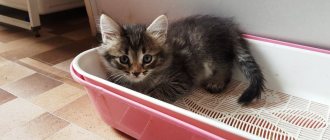Cat ears as an indicator of body temperature
Stress and excitement change the intensity of work of some internal organs in an animal.
Separation from the owner, a change in the daily routine, or other vivid emotions and impressions can have a negative impact on the general condition of the animal. It is important for a person to determine the cause of a cat’s anxiety. Perhaps correcting the diet, adapting to a new place of residence, or getting used to the child will help solve it. Animals always subtly sense the excitement and negative emotions of those around them, so they try to mirror them. As a result, unusual changes occur in the process of heat exchange in the body.
Cats can adapt to external changes almost instantly. However, at home they dream of feeling as protected as possible. The animal establishes a unique contact with its owner and habitat. Almost all breeds are quite sociable and are ready to adapt to a new place of residence at any time. However, this process is influenced not only by external, but also by internal factors.
We have already found out that the ears can be called an indicator of body temperature, since in cats covered with fur, a sharp change in this indicator can only be felt in the ears, mucous membranes and sometimes the nose. Pets have a higher body temperature than humans. Hairless cats have the same temperature as their furry cousins, but a hairless cat feels hotter to the touch.
The ears can indeed tell you that the cat has a fever, but in this case the shells will be red. Normally, a cat's ears look pale pink or white; redness indicates increased blood pressure and, most likely, an increase in body temperature.
Since the ears alone do not serve as an indicator, to tactilely determine the cat’s body temperature, the sensations during palpation are assessed in a complex:
- The nose, which should be damp and cool when the cat is active.
- Armpits.
- Mucous membranes of the oral cavity.
The only true indicator of a cat's body temperature is measured with a thermometer. Never rely solely on your tactile sensations. Elementary, your blood pressure may be low, which makes your hands a little colder, and the cat seems hotter. If your pet is alert, active, eats and drinks well, but at the same time it seems to you that he is hot, you should not draw conclusions about an elevated temperature. Observe, and if unsure, measure the temperature with a thermometer.
A cat's body temperature changes by about 1°C during the day. For example, if your cat has one ear hotter than the other, she most likely slept on her side and there is no cause for concern. A cat may appear very hot if it has been resting near a radiator or sleeping under a blanket. No, the blanket does not warm your pet, but it allows you to retain body heat, which can give false tactile sensations.
The temperature of the ears can fluctuate greatly depending on various factors:
- Ears may appear hotter if the cat: Has been actively playing.
- Sleeping.
- I experienced stress.
- Located in a room with a temperature above 25°C.
- The cat comes out of anesthesia - in cats after castration, thermoregulation can be impaired for up to 12 hours, in cats after sterilization up to 20-24 hours, provided that the operation took place without complications.
Since in most cases a cat's hot ears are not an indicator of illness, if you suspect something is wrong, it is better to observe your pet before contacting a doctor. Try to analyze the behavior and condition of the cat during the day, you should be interested in the following points:
- Take several control temperature measurements, 2-3 will be enough - this is the clearest indicator of the pet’s condition. However, not all illnesses and conditions cause an increase in temperature; sometimes the indicator can be underestimated, sometimes normal.
- When the cat's ears seem hot, note that if changes occur after eating, sleeping, activity, or stress, this will be normal. If changes in body temperature follow other events, be sure to record this.
- How often does a cat eat, provided that the diet is balanced - two or three times, this is the norm. If your cat asks for food more often, there may be an increase in body temperature due to insufficient nutrition. If the cat accepts food reluctantly or does not eat anything, you should be wary.
- Is the cat active? Depending on the animal’s temperament, activity is expressed differently. The cat must respond to its name, respond to stimuli; the reluctance to play or spend energy in other ways can be explained not only by illness, but also by a bad mood.
Situations requiring medical attention
Unfortunately, in some cases, coldness in a given area of the body signals emerging pathologies. For example, if your pet's ears suddenly become frozen, you should consult a veterinarian. The animal's condition becomes more complicated if the ears become bluish or become too pale. Often, icy paw pads and ears are the primary signs of serious disorders in the functioning of the cardiovascular system. In addition, shortness of breath and other symptoms may appear.
Such ailments more often occur in older animals, less often they are congenital in nature. Among the breeds prone to genetic pathologies in this area of the body, one can note British shorthairs, Scottish folds, sphinxes, red golls, Maine coons, etc. Owners are better aware of such risks and should more closely monitor the health of their pet.
If the pet is cheerful, playful and eats well, then cool ears should not bother the owner. However, if they turn into pieces of ice and the purr becomes painfully lethargic, do not put off a visit to the veterinary clinic.
A cat's body temperature in its normal state is plus 38 and even 39 degrees Celsius. And in cats without fur it is generally plus 41. But at the same time, the cat has cold ears and this is normal, because the body temperature of these animals is different from that of humans and in this case is completely normal. But why are your ears cold?
Increased ear temperature as a normal condition
The animal's limbs may periodically have elevated body temperature, but this does not indicate the presence of pathologies. First of all, a person may mistakenly think that the animal’s heat metabolism has accelerated. A cat's ears contain a large number of blood vessels that react almost instantly to any external changes. They are protected from the outside world only by a thin layer of wool.
Ears play a key role in the thermoregulation process of any animal. If they become hot, then it is not at all necessary to look for serious illnesses. For example, many cats simply love to sleep near the radiator during the cold season. In this case, body temperature is guaranteed to increase. An error can only be avoided if you re-measure after 15 minutes.
First of all, it is necessary to understand that the temperature of the ears and nose of cats can increase under the influence of certain external factors and vary depending on the time of day.
For example, your pet has just woken up, or has been actively playing and playing mischief for a long time, or has been in a warm, unventilated room, or has even experienced severe stress. Hyperthermia can occur in newborn kittens and pregnant cats.
If the result of an increase in temperature is stress, then the animal must be calmed. In case of fever due to being in a stuffy room, move the cat to a cooler room, provide ventilation, turn off the heating.
But what you shouldn’t do is panic and sound the alarm ahead of time. Cats' ears are very thin, covered with delicate short fur. When you touch an organ, it may seem that the temperature is higher than usual, but often this sensation occurs due to the difference in the skin of a person and an animal.
We suggest you read: Popular laxatives for constipation in cats
The ears of mammals, including cats, serve as the main part of the body that participates in heat exchange, so that the body does not overheat.
Before determining how hot the ears and nose should be for a particular breed, you need to read its description, because each species has its own indicators.
In addition, there are several factors that objectively increase body temperature:
- after physical activity of the animal - for example, after playing with a cat;
- immediately after waking up, cats’ ears are also somewhat hotter than usual, and besides, the nose is dry in the first minutes - this is also a physiological norm;
- due to the established hot weather in the summer;
- due to the fact that the cat slept on the floor, as a result of which one of its ears cooled down, and the temperature of the second, on the contrary, increased;
- in a stressed state, the temperature of the body as a whole, including the ears, rises by several tenths of a degree, which is quite normal.
Thus, if an increase in the temperature of the cat’s ears and head is observed irregularly, as a result of explainable reasons, such conditions are normal, so there is no need to fear for the health of the animal.
How to help an animal
Hot ears in a cat are not a pathology in themselves, which means that trying to cool only one ear (for example, by applying ice compresses) is pointless. The first thing to do is to examine the animal for other symptoms. If they are not there, then you should leave the cat alone for 20–30 minutes and feel the ears again - in a healthy animal, by this time the blood flow will normalize and the skin will no longer be hot.
When fiery ears are still a symptom of some kind of disease, it is necessary to begin treatment. It depends on the diagnosis:
- If the ears are burning due to severe stress, then first you need to create the most comfortable conditions for the cat and remove all irritants. There is no need to forcefully try to pick up the animal or stroke it (this will only increase the stress). It is better to provide maximum peace, but leave water and tasty food nearby. If after a couple of days the cat’s mental well-being is not restored, veterinarians will prescribe sedatives: Clomipramine;
- Cat Baiyun;
Kot Bayun is a sedative medicine based on natural herbal ingredients - Fitex;
- Vetspokoin;
- Anti-stress;
- Phospasim;
- Vetranquil.
- Surolan;
Amitrazine is a veterinary drug that is used for cats in the treatment of pathologies caused by sarcoptic mites
During treatment of otitis media, ear mite infection, and after surgery, the cat must be wearing a medical collar that prevents the animal from scratching the sore ear.
If the cat has a fever
If the ears are hot, you need to make sure that the animal’s body temperature is normal. If you don’t have a thermometer, just feel the animal’s nose - it should be cold and wet when awake. If you have a temperature measuring tool at home, you should use it. For an adult cat, readings below 37.5˚C and above 40˚C are a serious reason to immediately contact a veterinarian. Fever occurs when:
- infectious diseases;
- poisoning;
- tumors;
- allergies.
The cat has hot ears - possible causes
A person is required to show maximum care and affection. If a deficit of these senses does not occur, then the animal will be able to feel comfortable in any conditions.
A cat's ears are hot when it has experienced immediate stress. Additionally, the situation is accompanied by an increase in heart rate and body temperature. Symptoms most often appear against the background of the following situations:
- Sharp fall.
- The tail was pinched, causing severe pain.
- The cat suffered from hypothermia.
When hot ears are a sign of illness
If the cat’s behavior has not changed, she is still cheerful and affectionate, eats well, sleeps and regularly visits the litter box, then there is no reason to worry.
But if, in addition to hot ears and nose, additional signs are noted, then the animal should be shown to a veterinarian, because a cat’s hot ears (sometimes red) can be a sign of:
- viral infection;
- infectious diseases;
- intestinal disorders;
- injuries, hematomas;
- bladder stones;
- colds;
- Otodectosis (ear mites).
Under no circumstances should you make a diagnosis yourself, much less begin treatment; this can only harm the cat’s body.
The most common cause of the phenomenon of a cat having hot ears is ear scabies (otodectosis). If you suspect an ear mite, it is necessary to inspect the ears.
The presence of brown plaque, lumps of dirt, and crusts dried from scratching in them means that the pet has parasites. If at the same time the animal behaves restlessly, shaking its ears and head in one direction or the other, this confirms the diagnosis.
Otodectosis of the ear is a serious disease that brings some discomfort to the animal. In addition, in advanced cases it leads to otitis media, which, in turn, leads to partial or even complete hearing loss.
The use of special drops for ear scabies will eliminate the disease. As a rule, doctors prescribe Bars drops for the withers. When otitis occurs, antibiotics are used.
When identifying pathology, analysis of the pet’s behavior and its reaction to external changes is of no small importance. If there are serious deviations in the cat, the daily routine and sleep patterns are guaranteed to change. He may sleep more or vice versa less. At the same time, his ears always remain hot. In this case, otitis media or other inflammatory processes are most often diagnosed.
An increase in body temperature in a furry patient is observed after injury. In this case, an active development of the inflammatory process is observed in his body. This symptom certainly accompanies infectious diseases, pathologies in the gastrointestinal tract and the formation of stones.
If a cat is suspected of developing an illness, then it is necessary to regularly check the condition and temperature of its nose. The norm is a situation in which it remains cold and wet. Otherwise, treatment must be started. Otherwise, the risk of developing serious pathology increases.
Upon detailed examination of the cat, an increase in ear temperature can be noted. It also has a red color - a clear sign of an inflammatory process. The situation is typical for an ear hematoma. The disease is diagnosed when a blood vessel is damaged. There were no external symptoms of bleeding.
The hematoma is quickly eliminated by applying the drug. Only a veterinarian can choose the right one.
Scabies or ear mites develop when a cat produces large amounts of wax. Upon detailed analysis, an unpleasant odor can be detected. It leaves a plaque on the inside of the ear. The animal experiences severe discomfort as the ear begins to itch. During the treatment process, it is advisable to use drops that will relieve the animal from the unpleasant manifestation within a few days.
When should you be concerned?
The ears of cats can be cold and this is not a sign of illness. Therefore, there is no reason to worry, but you should be concerned in the following cases:
- ears are so cold that they are almost bluish at the tips, this means that the cat has some kind of heart problem, and something needs to be done to quickly get the pet to the doctor;
- if in general the cat behaves apathetically, loses its appetite, moves little, while its nose is dry and its ears are not warm, all these are indeed manifestations of some kind of disease.
With such abnormal behavior of a pet, only a veterinarian can help, who, during an examination, will determine what is wrong with the cat and prescribe the necessary medications.
If the cat feels comfortable and is not cold, then her ears will be slightly cool, but under unfavorable environmental conditions they will be completely cold.
How to care for a cat's ears?
When caring for your pet, it is very important not to forget about ear hygiene. Regular examination by the owner of his pet will help him notice the signs of an incipient disease in time and prevent its development. In this article we will talk about how to clean a cat’s ears and what to look for during an examination in order to promptly detect the first signs of ear disease.
What do healthy cat ears look like and what are the signs of disease?
Healthy cat earSick cat ear
Upon external examination, healthy ears should be clean, pink, without crusts or black spots. Compare both ears - do they look the same?
Signs of the disease may include: – reddened ear canals – the presence of dark spots – swelling – pimples – the presence of crusts – discharge from the ear – an unpleasant odor – restlessness of the animal when the cat constantly shakes its ears or scratches its ears
The most common causes of the above symptoms are ear mites and otitis media. If these symptoms appear, you should immediately contact a veterinarian, as any attempts at self-medication can greatly aggravate the situation. To clarify the diagnosis, you can also take an ear smear.
How to clean a cat's ears - step-by-step instructions. Cleaning cats' ears involves removing contents from the ear canals using cotton swabs.
- Secure the animal. To do this, you can, for example, carefully (!) wrap the cat in a towel.
- Take the tip of the ear with your thumb and forefinger and gently pull it back, turning it outward as far as possible so you can see the inside.
- Insert a dry cotton swab into the ear canal approximately 1 cm. Do not be afraid to injure the eardrum - due to its special anatomical structure, you will not be able to reach it. To clean your ear well, you may need several cotton swabs.
- Use an outward rotating motion to remove the contents from the ear canal.
- If necessary (if there are crusts or discharge), you can use a cotton swab dipped in hydrogen peroxide and wrung out well to clean your ears (ears don’t like moisture!).
- Unless specifically prescribed by a doctor (in case of otitis media or ear mites), do not pour any medications into your cat’s ears.
A cat's healthy ears should be cleaned no more than once every 2 weeks.
Hot ears as a symptom
There are a lot of blood vessels in a cat's ear.
However, in some cases, an increase in temperature may indicate that the cat has actually begun to develop some kind of disease. In this case, you should always pay attention to the accompanying symptoms:
- The animal looks lethargic, inactive, sleeps a lot and rarely plays, practically not reacting to affection.
- If a cat constantly has a dry nose, even during the day when she is awake, this is a sign of an obvious disease, possibly viral.
- If at the same time the animal has lost its appetite, vomiting has begun, and profuse loose stools are observed - most likely, the cat has become infected with a viral infection.
- Finally, after giving birth, older (and sometimes young) cats may experience an increase.
Now let’s figure out in what case hot ears can be considered as a symptom of a disease and what to do in this case. For further diagnosis, you need to step back from the main worrying indicator - hot ears. An elevated temperature does not always indicate illness; try to analyze what served as the impetus for activating the animal’s immunity.
If you go by the opposite method, for diagnosis you need to eliminate irritating factors as much as possible. Place the cat in a calm environment, provide it with food and water, and observe for several hours. If the pet has calmed down, responded normally to treats, and the alarming signs have disappeared, the cause of the elevated temperature is stress. Please note that stress is a very painful condition and can get worse.
A cat in a nervous environment cannot fully relax, which means it will not sleep deeply. The animal's immunity works fully only in the deep phase of sleep. It turns out that the longer a pet is stressed, the more defenseless her body becomes. If, after moving to a calm environment, the cat falls asleep and seems hot, it is better not to intervene; perhaps the rise in temperature is due to the fact that the body is fighting an infection.
We suggest you read: How to remove fleas from a cat at home, how to get rid of parasites from a kitten, where they come from from the animal, photo
Your pet may develop a fever due to heatstroke. The insidiousness of this condition is associated with the secrecy of cats. Symptoms can be so subtle that even an experienced owner may not notice the condition worsening. When heat stroke occurs, a cat suffers from intoxication, which is expressed by symptoms of poisoning.
A few words about dry and hot nose. This indicator is not informative, since it is normal if the cat was sleeping, dozing or at rest. A dry nose indicates low activity of the mucous membranes, which can be either a sign of illness or a normal variant. If you notice that your cat's nose often gets dry, make sure there is normal air humidity in the home. In winter, when heating appliances are operating, the air in the apartment dries out quickly.
Help should be provided without delay if the cat is clearly sick. Symptoms are very varied and depend on the type of disease. An elevated temperature close to 40° or higher is a very dangerous condition. First of all, you need to bring down the temperature without harming the cat. It is strictly not recommended to use paracetamol; it is toxic to cats.
The ears may be hot and red if your cat:
- Otitis - the sink looks dirty and inflamed; in advanced cases, a putrid odor is felt and dried pus is found.
- Ear mites - the cat quickly scratches its ears and face into blood. Scratches and brown specks will be found in the ears. If the infestation is severe and lasts several days, you will notice a brown coating somewhat similar to plasticine.
Otitis media is treated comprehensively, and the approach to treatment depends on the causes of the disease. You need to understand that ear inflammation can be either an independent disease or a consequence of another, secretly developing disease. In treating ear mites, the main thing is efficiency. The cat's condition will deteriorate very quickly. Scratching quickly becomes infected, which leads to inflammatory processes.
When should you visit the vet immediately?
In addition to the condition of the ears, pet owners are advised to pay attention to the nose. Normally it should be slightly damp and warm. If your cat has cold ears and a dry nose, it is recommended to take the temperature immediately. Typically, this sign indicates a cold, which, if left untreated, will result in serious complications for the animal.
In winter, cold ears often indicate hypothermia or even frostbite. The skin also changes color, becomes covered with watery blisters, and begins to peel off. Trying to independently help the animal, restore sensitivity and normalize blood circulation in the affected areas by rubbing or using hot heating pads is strictly prohibited. It is better to wrap your pet in a warm blanket and show it to the veterinarian - the doctor will determine the degree of frostbite and recommend effective treatment.
You should sound the alarm if other signs of disease are observed at the same time:
- the cat behaves restlessly, meows often, hides from its owners;
- constantly high or low body temperature (the norm for an animal is 37 degrees);
- a cold inside of the ear indicates inflammation and the presence of pus; if left untreated, the animal may completely lose hearing;
- the coat loses its healthy appearance, becomes dull and falls out profusely;
- the pet loses appetite, the belly feels tight and hot to the touch (the main sign of intestinal diseases);
- after eating, the animal vomits or prolonged diarrhea, in which blood particles are visible (a symptom of inflammatory processes on the mucous membranes or diseases of the digestive system).
Veterinarians do not advise trying to determine the disease on your own - only a special examination can diagnose a malfunction of organs or systems.
What to give a cat for hyperthermia
If you suspect your pet's hot ears are a sign of hyperthermia, take his temperature using a rectal thermometer.
It should be noted that the normal body temperature of cats is within 38 degrees, that is, higher than that of humans. At the same time, for representatives of certain breeds, for example, hairless cats, 41.5 °C is considered the norm.
If, when measuring your pet's temperature, it turns out that it is higher than normal, you need to take care of drinking plenty of fluids. As a rule, sick animals refuse food, but drink more than usual. Therefore, the cat should always have clean water at room temperature available.
In this case, the dosage must be strictly observed. Experts recommend using no more than 10 drops per 10 kilograms of weight. In addition to echinacea, you can use another medicinal plant - astragalus. The dosage is similar.
To boost immunity, the veterinarian may recommend a vitamin complex enriched with vitamin C. This is necessary so that the weakened immune system can recover and perform its direct function - to fight various infections.
Details and features of the inspection
At the first stage, it is necessary to carefully examine the ear from the outside. There should also be no cracks or abrasions inside the ear. External inflammation is diagnosed if several ulcers can be seen.
The behavior of a pet always becomes strange if otitis media develops in its body. He begins to periodically shake his head, scratch himself and does not allow his owner to touch him. Additionally, liquid with an unpleasant odor is released from the ears. In this case, inflammation of the inner ear can be confidently diagnosed.
Now let's look at the main question - why is it normal for a cat to have hot ears in most cases? Let's think about how the ear differs in structure from any other part of the body? That's right, between the ear cartilage and thin skin there is no muscle or fat layer. Even dark-colored cats have blood vessels and veins visible through the skin on their ears. To very generalize, the ear can be divided into three layers: skin, blood vessels and skin.
What, in a global sense, warms the body and gives it temperature? That's right, blood! For a person, the normal temperature is 36.6°, and for a cat the range is from 37.5° to 38.5°. A person quite subtly senses a temperature difference of 1–2 degrees. If you don’t believe me, you can check it - heat the water to 38° and put your hand in it.
Next, why do hairless cats seem so much hotter than furry ones? That's right, the reason is the lack of fur and the direct tactile sensation of the animal's skin. In addition, a hairless cat uses a lot more energy to keep itself warm. The blood of a hairless cat is literally hotter than that of a furry cat. Simply put, if your pet is a hairless breed and it seems to you that his ears are hot at times, most likely everything is fine.
We measure the temperature and select antipyretic drugs
Determining the body temperature of a pet can be quite difficult. For this, the rectal method is most often used. Apply a small amount of Vaseline to the thermometer. After this, the tip is slightly inserted into the anus.
If an elevated body temperature is detected, the animal should be provided with sufficient fluid. It is best to move it to a cool room. Echinacea helps to quickly and effectively lower a cat's temperature. It must be taken in the amount of ten drops per kilogram of animal weight. The dosage must be previously agreed with the veterinarian.
If your cat has a hot nose and ears, you should immediately visit the veterinarian's office. Most likely, inflammation is actively developing in the animal’s body. A properly selected course of treatment is guaranteed to quickly relieve your cat of unpleasant symptoms.
We invite you to read: Day-old ducklings, what conditions do they need?
Hot cat ears?
By touching the animal's ears, a person, due to the difference in body temperature, may feel that the kitten's ears are hot and begin to worry. In fact, this phenomenon is considered normal, especially for hairless species.
To finally get rid of worries, you can touch the animal’s nose. If it is cool and a little damp, and the pet is still active (running, playing or eating), then it is absolutely healthy.
Also, you should not be bothered by going to the veterinarian with the problem of why the cat has hot ears, if the pet does not have other obvious signs of illness, and he himself demonstrates an excellent appetite and cheerfulness, and has a normal body temperature. It is quite possible that he is simply hot, as can be guessed by his frequent feeding of the sippy cup and the search for cool places to rest.
However, if a cat’s hot ears occur along with a high body temperature, then it is quite possible that the pet is sick. You need to measure the temperature rectally, lubricating the tip of the thermometer with Vaseline or oil. Hold the measuring device for at least three minutes.
If a cat has hot, red ears that it constantly scratches, it may indicate that the animal has ear mites. Also an alarming sign is swelling and decay of the external hearing organs, which is an important reason to urgently visit a veterinarian.
When not to worry
The ears appear hotter than other parts of the cat's body due to the fact that there are blood vessels under thin skin that is not protected by fur. Due to their location, they quickly heat up from the sun, lamp, radiator and also cool down quickly (it is by the ears that you can determine that the animal is freezing).
From a heat source, the ears heat up faster than other parts of the cat’s body, since there is a dense network of capillaries, as close as possible to the skin
Warm ears themselves are not an indicator of fever (unlike a dry nose in an awake cat). But you should play it safe and measure the general body temperature of the beast with flaming ears (this is done using a rectal thermometer). The norm is:
- in a newborn kitten - 35.1–36.1 °C;
- for kittens up to six months - within 38.5–39.5 °C;
- for adult cats - 37.5–39 °C.
It's okay if the cat has hot ears, but the general body temperature is fine and there are no other alarming symptoms. Just in case, feel the animal’s ears after a short period of time - if the animal is overheated or nervous, then after 15–20 minutes the skin will again feel normal to the touch.
What can hot ears indicate?
Cats are digitigrade; they walk using their toes. Walking and running on your toes increases the chances of a successful hunt, because the speed of movement increases, the stride lengthens and noiselessness is ensured.
The front paws are ideal grooming tools. With the help of their front paws, animals clean hard-to-reach places - the area behind the ears, neck, muzzle. Cats first lick their paw several times, moistening it with saliva, and then wash themselves with it. Kittens begin to wash themselves using their front paws when they reach 4 weeks of age.
How many fingers does a cat have?
Cats usually have 18 toes. The front feet have five toes and the hind feet have four toes. However, there are individuals with a large number of fingers due to a genetic mutation - polydactyly. If one parent had the mutation and the other had a normal number of toes, then up to 50% of kittens will be born with polydactyly. A cat from Canada with 27 toes was included in the Guinness Book of Records.
Extra toes are not harmful to health and do not interfere with the normal life of the animal. But caring for claws becomes more complicated; trimming claws requires more time and care.
The feet of some individuals with polydactyly are mitten-shaped (with a thumb like a hand) due to the extra toes on the side. The owners of such pets observed their ability to open windows independently, in which the animals were helped by their thumb.
There are certain breeds (Maine Coon) in which polydactyly is considered a breed feature and is not a disadvantage.
Cats sweat through their paws
The small pads are unusually sensitive and contain a large number of nerve endings. Thanks to the sensitivity of the pads, cats feel the texture of surfaces and feel vibrations, which allows them to estimate the distance to prey.
The paw pads are resistant to adverse environmental conditions, but they are very sensitive to low and high temperatures. Soft pads are quickly damaged when in contact with the surface of hot asphalt or icy sidewalks.
The front legs and paws of cats are weaker, but larger than the hind legs. These animals can climb up very well, clinging and holding on with their claws, but their claws do not help them with their descent. Cats often cannot descend on their own from great heights; they have to jump and, thanks to the pads, the blow is softened when landing. They seem to land gracefully and easily without feeling any pain.
The pigmentation of the pads matches the coat color. Colored cats often have black spots on their pads; gray cats have grayish pads; black cats have black pads; white and red cats have pink pads.
Meowing pets sweat through their paw pads. This cooling system protects the body from overheating. But animals sweat not only when they are hot, but also when they experience fear and stress.
It is noteworthy that by scratching surfaces, cats leave an odorous mark for other cats. The mark carries information that the given territory is occupied. Scent glands are located on both the front and hind legs.
The print of a cat's paw is round, without traces of claws, because representatives of the family walk with retracted claws that do not touch the ground. The paws leave a mark of four toes and, no matter the hind leg or the front leg, and the metacarpal soft.
Paw sensitivity
Many domestic cats do not allow people to touch their paws. The limbs are the cat's first line of defense against the enemy, which is why they are so sensitive and, in the cat's opinion, must be constantly ready for defense. However, sometimes we manage to touch them while resting. A cat who is relaxed may tolerate this form of contact for a while. This is also proof that he doesn't consider you a threat to his safety. That's when we can examine the feet and see if they are too cold.
Why do cats have hot or cold ears?
The two front fingers are located in close proximity to each other, while the side ones are slightly distant from the central ones. When landing a jump, a profitable fingerprint may be left behind. When pursuing prey, the tracks of the four legs come closer together.
The coolness of areas of the body without fur has a well-founded explanation related to the physiological characteristics of the animal. Since heavily furred cats do not have sweat glands on their bodies, excess heat generated by the body is released through the hair-free skin. This is why a cat that has no health problems may have cold noses, ears, and paw pads. In this case, we are talking about a completely normal phenomenon that does not require intervention.
In addition, the ears may be cold if the pet is cold. In this case, he can cuddle up to the radiator, climb under the blanket, or look for other warm places in the house. If this happens constantly, then it is worth intervening - put clothes on your pet and provide it with a covered bed. This is especially true for representatives of breeds that naturally do not have a “fur coat”.
Why do the tips of my ears get cold?
Again, you can turn to the anatomical features of the animal’s body. The ear has few blood vessels, and the auricle itself is just thin cartilage covered with thin, delicate skin. The closer the ear is to the sink, the more its skin thickens.
The absence of blood vessels means that these areas without blood circulation do not receive heat. That is why the very tips of the ears, if you touch them, remain cool. This is a natural state and there is no need to worry about it.











